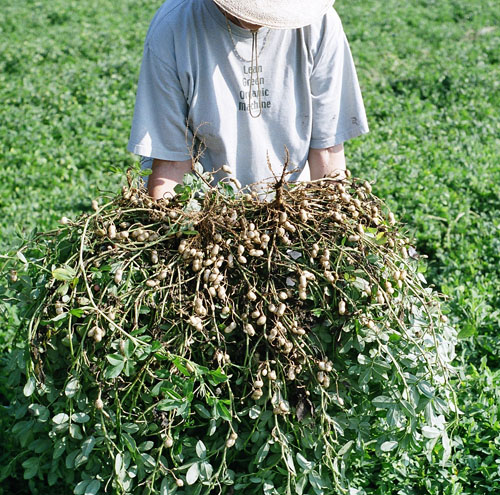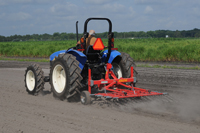Tifton, Ga. - University of Georgia researchers studying organic peanut production and researchers with the USDA’s Agricultural Research Service have found ways to reduce the amount of chemicals used in traditional peanut farming operations.
Supported by a series of Southern Sustainable Agriculture Research & Education (SARE) grants, the critical breakthrough in the overall research effort was a weed control strategy based on intensive cultivation. This includes using the right equipment in conjunction with cultural practices that enhance peanut competition with weeds.
The production system - validated on certified organic fields - works, said Carroll Johnson, a USDA-ARS research agronomist with the UGA campus in Tifton.
“We went through several years of consistent failure before we started seeing regular successes in weed control techniques,” Johnson said. “Since then, we’ve had a pretty good idea of how to manage weeds in organic peanut.
“At our research site in Tifton, we were heavily infested with the major weeds that plague peanut growers: crab grass, Texas millet, crowfoot grass and small-flower morning glory, just to name a few. We gave our organic weed control systems a real-world test.”
A key to successful weed control is finding the right cultivation implement, and that implement turned out to be the tine cultivator, Johnson said.
“The saying goes that if you see a weed, then it’s too late,” he said. “When properly operated, the tine weeder eliminates the weed before it even has a chance to emerge from the soil.”
The magic behind the tine cultivator is the flexible tines that scratch just beneath the soil, bringing the weed seedlings to the top where they dry up and die on the soil surface.
“I usually start using the tine cultivator right before the peanut crop emerges and then repeat at weekly intervals for six weeks,” Johnson said.
Another interesting development during the research was the awareness that peanut is much more tolerant than originally thought to the intensive cultivation needed to control weeds.
“We basically took the peanut production handbook and put it through the shredder,” Johnson said. “We were doing things to peanut with intensive cultivation that had not been done before and getting away with it, and that is due to the superior peanut varieties now available to growers.
“There are some resilient peanut varieties out there that have enough disease resistance and tolerance to the physical abuse of intense cultivation that makes it possible for us to produce organic peanuts in the first place. That was an important discovery right there.”
The team was concerned that leaf funguses and soil-borne diseases would be limiting factors due to the absence of fungicides but that has not been the case, Johnson said.
“We have outstanding peanut varieties that give us disease tolerance or even resistance, along with strong yield potential,” he said.
But the right varieties and the right implement are still not quite enough to thoroughly control weeds.
“During the on-farm validation of effective cultivation regimes for weed control, it became clear that we needed to have uniform, almost perfect, stands of peanut plants to eliminate any gaps in the row where weeds could get a foothold,” Johnson said. “That’s where one of the SARE grants, led by Mark Boudreau, came into play.”
Boudreau, with UGA College of Agricultural and Environmental Sciences, coordinated research that identified the ideal combination of row spacing, row geometry, and seed spacing.
“The best system is peanut rows spaced 36 inches apart with six to eight uniformly spaced plants per foot of row,” Johnson said. “That eliminates gaps (skips) in the row where weeds can grow. We were able to demonstrate that production system on a large scale in an organic transition study led by Scott Tubbs.”
Tubbs, an assistant professor of crop physiology and management at the UGA campus in Tifton, received a SARE grant to study peanuts in an organic transitional system at three locations across Georgia, one of which was in Tifton.
“In those experiments at Tifton, the yields on two acres of organic peanuts averaged 5,211 pounds per acre in 2011. The 2011 state average was 3,400 pounds per acre,” Johnson said. “The results of the study showed that we can grow peanuts organically and it’s doable on larger scale, not just small research plots.”
Johnson credits J. Frank McGill, a former UGA Cooperative Extension agent and retired UGA peanut specialist. Known as “Mr. Peanut,” McGill is considered one of the pioneers of modern peanut production in the South.
“Once we developed a rough prototype of an organic peanut production system, Frank and I were visiting a certified organic peanut farm in Screven County,” Johnson said. “Frank took one look at the planting, which looked impressive, and gave our team an enthusiastic thumbs-up. Coming from the preeminent expert in peanut production, I knew that we were on the right track.”
Those research successes in organic peanut production have led to similar efforts on other specialty crops, like organic Vidalia sweet onion.
“The organic Vidalia sweet onion is a very high dollar, intensively managed crop. The production budget assumes weed control costs of $1,000 per acre, by hand,” Johnson said.
“We were able to control weeds using the tine cultivator on transplanted organic Vidalia onions for $25 or $30 an acre,” he added. “We tend to baby the Vidalia onion with extra inputs, like fungicides, but we were able to manage organic Vidalia onion without such inputs and produce yields comparable to state yield averages. “
Johnson and USDA-ARS research technician Dan Evarts were recently awarded the 2012 Land Stewardship Award from Georgia Organics for their research and outreach efforts in weed control strategies in organic peanut. While the award emphasizes contributions toward organic agriculture, the products from the research effort that work in organic production can also work in conventional systems, said Johnson.
“I find it very interesting that peanut and Vidalia sweet onion are both intensively managed specialty crops and research on organic production systems for both crops points in the same direction,” Johnson said. “Both crops can be successfully grown organically and the discoveries on organic production in both crops can be extended to conventional production systems and reduce costs of production.”









